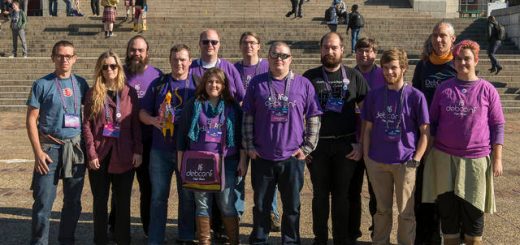New Kid on the Block
I used to be a huge fan of Slackware and SuSE Linux. I loved Slackware for being so heavily oversimplified. And I enjoyed SuSE for all it’s bloat and YaST and all the things that came with it. I used to use SuSE on all my bigger machines, and Slackware on the older, slower machines.
When I started working at TSF, I thought that it might be a good idea to start using Debian. I’ve installed Debian before, but hated it. All the software was outdated, and it still shipped with Gnome 1.6 and used GTK 1 applications (yuck). I asked Thomas Black, open source program manager at the time, to show me what he thinks is cool about Debian. He showed me how to dist-upgrade to unstable, and it was awesome. Every single day, there were new packages available, and I had the latest and greatest software all the time. I very quickly started moving all my machines to Debian, and learned to love it very quickly.
Thomas then told me that Mark is looking going to support updates to the unstable Debian branch. Putting it like that sounded a little strange, but then he handed me a CD that he downloaded from http://no-name-yet.com. He said that it was made by “the warty warthogs”. For the most part, it looked like a standard Debian install, although there were less questions and somehow it felt more pleasant. I remember how we laughed when we saw the first naked people mockups on GDM. And how nice it was to have a Debian setup that just works more the way you’d want it to.
Since that first release, many things have changed. In Warty, the main section was only a bit more than 500MB large. Now, if my calculations and assumptions is correct, it’s about 3.5GB. Universe has also grown, and now Ubuntu gives you one of the finest collection of packages you’d find in any operating system.
What’s more is, the installation options have grown. Every release after Warty, a new baby distro was born. The first baby was Kubuntu, and has grown up very quickly. So much in fact that other commercial distributions, such as Impi Linux has based their distribution on it. Then came Edubuntu, an Ubuntu setup that saves lab administrators time by automating much of the setup, by including as many educational software on the CD that will fit on it, as well as automatically setting up the LTSP environment. Edubuntu has also come a long way since its first release. LTSP now uses much, much less RAM on the thin clients, and it boots up very quickly. Congratulations to ogra, your hard work had really made a difference to many :)
With the 6.06 LTS release, however, we see a new Ubuntu kid on the block. This time it’s Xubuntu. Xubuntu fills that gap a bit nicer for what I used to use Slackware for. It ships with the Xfce desktop environment, which is clean, simple and fast. It’s also less CPU and memory intensive, and is great for use on terminal servers. Jani Monoses has been incredible, and have done some great last minute work to get LTSP into Xubuntu. You can now choose “Install LTSP server in Xubuntu, just like you would with Edubuntu. Happy birthday Xubuntu! Welcome to the tribe!








Hi,
I’m a student and actually working on a small project concerning LTSP and am currently using Xubuntu. The interface is real nice and i would like to know if there exists some guide for newbies.
I have already installed the LTSP server from the bootable CD and do not know how to proceed further…please help..:-)